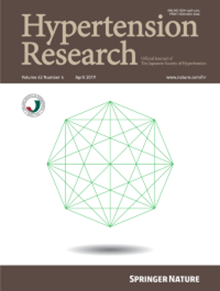体重指数和肌肉疏松症与老年高血压门诊患者的死亡风险;南部队列研究。
IF 4.3
2区 医学
Q1 PERIPHERAL VASCULAR DISEASE
引用次数: 0
摘要
通过改变生活方式来保持理想体重和肌肉力量,对于改善高血压患者的日常生活能力(ADL)和预期寿命至关重要。然而,减轻体重对老年高血压患者的影响还存在争议。我们对老年高血压患者的体重指数(BMI)和握力(HG)的预后意义进行了评估。根据 BMI 和 HG 的组合对患者进行分层。采用 COX 回归分析评估死亡风险。共对 563 名患者(年龄 77 [71-84] 岁,50% 为男性,40% 为体弱者)进行了随访,中位随访时间为 41 (34-43) 个月。随访期间共有 59 人死亡。根据体重指数水平对死亡率进行的验证显示,体重指数为 2 的患者可能有更高的死亡风险。而低 HG 患者的死亡风险则增加了 3.7 倍。根据体重指数和 HG 值得出的全因死亡风险(调整后危险比[95% 置信区间])如下:(1)正常 HG + 22 kg/m2 ≤ BMI,参考值;(2)正常 HG + BMI 2,2.39(0.12-16.46);(3)低 HG + 22 kg/m2 ≤ BMI,4.01(1.42-14.38);以及(4)低 HG + BMI 2,4.55(1.33-18.13)。这些研究结果表明,减轻体重可能会降低老年高血压患者的死亡风险,因此有必要为老年高血压患者制定新的生活方式调整策略,以改善其日常活动能力、生活质量和预后。我们评估了体重指数、手握力和全因死亡风险之间的关系,以评价减轻老年高血压患者体重的有效性。本文章由计算机程序翻译,如有差异,请以英文原文为准。

Body mass index and sarcopenia and mortality risk among older hypertensive outpatients; the Nambu Cohort Study
Maintaining ideal body weight and muscle strength through lifestyle modification is essential for improving activities of daily living (ADL) and life expectancy in hypertensive patients. The effect of weight reduction in older patients with hypertension, however, is controversial. We evaluated the prognostic significance of body mass index (BMI) and handgrip strength (HG) in older patients with hypertension. Patients were stratified by the combination of BMI and HG. COX regression analysis was used to assess the mortality risk. A total of 563 patients (age 77 [71–84] years, 50% male, 40% frailty) were followed for a median duration of 41 (34–43) months. In total, 59 deaths occurred during the follow-up period. Validation of mortality by BMI level revealed that patients with BMI < 22 kg/m2 were likely to have higher mortality risk. Low HG, however, was associated with a 3.7-fold increased mortality risk. The risk of all-cause mortality using BMI combined with HG (adjusted hazard ratio [95% confidence interval]) was as follows: (1) Normal HG + 22 kg/m2 ≤ BMI, reference; (2) Normal HG + BMI < 22 kg/m2, 2.39 (0.12–16.46); (3) Low HG + 22 kg/m2 ≤ BMI, 4.01 (1.42–14.38); and (4) Low HG + BMI < 22 kg/m2, 4.55 (1.33–18.13). These findings demonstrate that weight reduction may deteriorate the mortality risk in older patients with hypertension, and new lifestyle modification strategies for improving ADL, quality of life, and prognosis are warranted for older patients with hypertension. We assessed the association between BMI, handgrip strength, and risk of all-cause mortality to evaluate the validity of weight reduction in older patients with hypertension.
求助全文
通过发布文献求助,成功后即可免费获取论文全文。
去求助
来源期刊

Hypertension Research
医学-外周血管病
CiteScore
7.40
自引率
16.70%
发文量
249
审稿时长
3-8 weeks
期刊介绍:
Hypertension Research is the official publication of the Japanese Society of Hypertension. The journal publishes papers reporting original clinical and experimental research that contribute to the advancement of knowledge in the field of hypertension and related cardiovascular diseases. The journal publishes Review Articles, Articles, Correspondence and Comments.
 求助内容:
求助内容: 应助结果提醒方式:
应助结果提醒方式:


